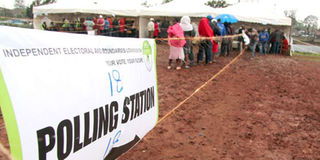Low voter turnout wrong grounds to dispute poll results

Voters in Kamukunji withstand the chilly weather on October 26, 2017 to vote in the repeat presidential election. Kenya is a democracy where the rule of law determines who wins. PHOTO | KANYIRI WAHITO | NATION MEDIA GROUP
What you need to know:
- There was fear of violence in some areas where some youth barricaded roads and attacked electoral officers.
- While low turnout may point to division and voter apathy, it cannot be used to determine a winner.
On October 29, Independent Electoral and Boundaries Commission chairman Wafula Chebukati declared Mr Uhuru Kenyatta President-elect following the October 26 rerun presidential repeat election.
As Jubilee Party supporters erupted into jubilation, reading the whole matter as a validation of Mr Kenyatta’s triumph in the August 8 election that was nullified by the Supreme Court, the opposition coalition vowed never to recognise Mr Kenyatta as having been validly elected.
Among the reasons advanced for disputing Mr Kenyatta’s declaration as winner was the low voter turnout.
ELECTORAL OFFENCES
National Super Alliance (Nasa) leaders said the IEBC kept vacillating about the number of voters who turned up to vote on October 26.
The opposition leaders claimed the turnout was less than 30 per cent and that the figures were inflated before the announcement of Mr Kenyatta as winner.
While Kenya is a democracy where people have a right to question an election and even seek its nullification in court, a few fine points expose the low voter turnout narrative by Nasa as hopelessly shaky and self-defeatist.
First, it must not be forgotten that in the Supreme Court ruling of September 1, which nullified the August 8 presidential election results, the majority view was that President Kenyatta had committed no electoral offences.
SUPREME COURT
Second, and equally important, nowhere in the ruling did the judges say the “illegalities and irregularities” in the poll meant that Nasa leader Raila Odinga had won.
Actually, Nasa lawyers, aware that their candidates had lost, kept saying “the numbers do not matter”, which in itself was an admission that they were only capitalising on the hitches in the transmission of results to argue their case.
It is, therefore, comical to turn around and argue that since the turnout was low in the repeat election, it shows they had won in August.
After the nullification of the August 8 poll, Nasa insisted that the election was “as good as something that never happened”.
POLL BOYCOTT
Another false narrative that must be debunked is that the low turnout in the fresh election was a vote of no confidence in the Kenyatta presidency.
First, we must be honest on why the voter turnout was so low.
Anyone with above average reasoning would have expected that when Mr Odinga withdrew from the race, even though he did not sign the requisite form 24, the numbers were bound to be lower.
No one disputes that the Nasa candidate has a huge following in the country, and that a good number of those supporters were bound to stay away when their leaders prevailed upon them to do so.
The total number of registered voters was about 19 million.
VOTERS
In the hotly contested August 8 poll, more than 14 million people voted.
It was to be expected that if almost six million Nasa supporters stayed away, then the voter turnout would fall by an almost similar number, which is what happened.
Even in the so-called Jubilee strongholds, any basic understanding of Kenyan politics would explain why some of the party’s voters did not bother to brave the morning chill and cast ballots in an election their favourite was bound to win anyway.
In addition, there was fear of violence in some areas where some youth barricaded roads and attacked electoral officers.
DEMOCRACY
Even without Nasa’s violent efforts to bring down the voter turnout, Kenya is a democracy where the rule of law determines who wins.
The Constitution is clear on what a validly elected presidential candidate must attain.
Mr Kenyatta garnered the constitutional requirement of 50 per cent plus one of the votes cast and more than 25 per cent in more than half of the counties.
This, therefore, means that the talk about voter turnout and legitimacy is a political debate and not a legal one.
WINNER
Besides, even in the developed world, including the United States, low voter turnout is hardly the grounds to bandy around to dispute electoral results.
In Switzerland, in 2015, only 39 per cent voted in legislative elections.
Voter turnout in the 2016 presidential primaries in the US was way below tradition.
While low turnout may point to division and voter apathy, it cannot be used to determine a winner.
The writer is a communications consultant




